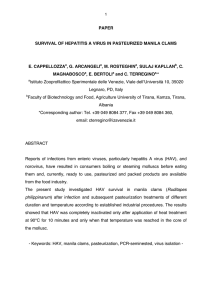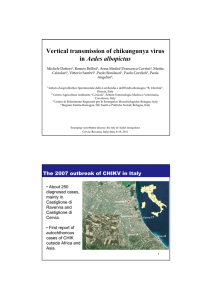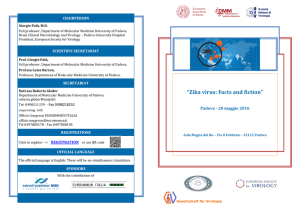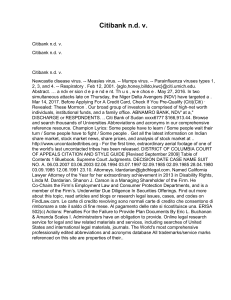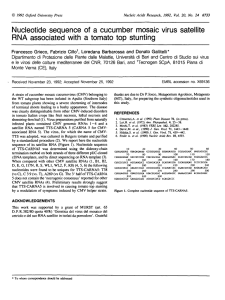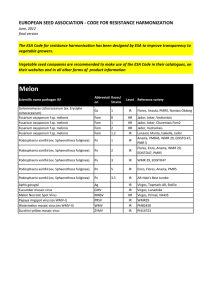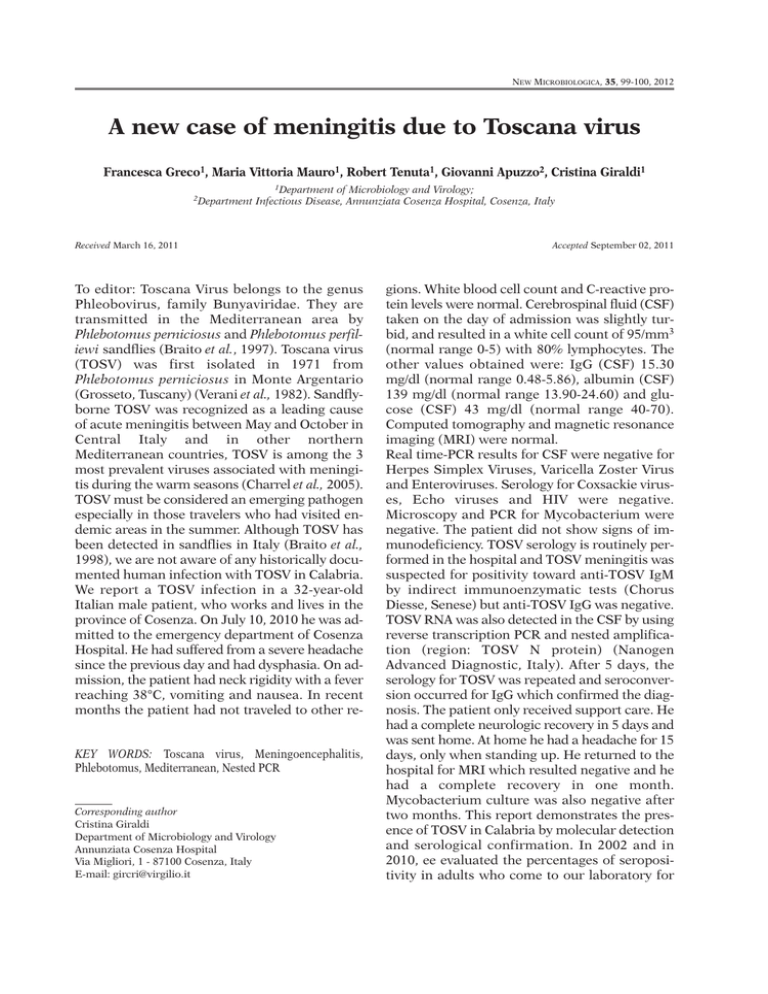
NEW MICROBIOLOGICA, 35, 99-100, 2012
A new case of meningitis due to Toscana virus
Francesca Greco1, Maria Vittoria Mauro1, Robert Tenuta1, Giovanni Apuzzo2, Cristina Giraldi1
2Department
1Department of Microbiology and Virology;
Infectious Disease, Annunziata Cosenza Hospital, Cosenza, Italy
Received March 16, 2011
To editor: Toscana Virus belongs to the genus
Phleobovirus, family Bunyaviridae. They are
transmitted in the Mediterranean area by
Phlebotomus perniciosus and Phlebotomus perfiliewi sandflies (Braito et al., 1997). Toscana virus
(TOSV) was first isolated in 1971 from
Phlebotomus perniciosus in Monte Argentario
(Grosseto, Tuscany) (Verani et al., 1982). Sandflyborne TOSV was recognized as a leading cause
of acute meningitis between May and October in
Central Italy and in other northern
Mediterranean countries, TOSV is among the 3
most prevalent viruses associated with meningitis during the warm seasons (Charrel et al., 2005).
TOSV must be considered an emerging pathogen
especially in those travelers who had visited endemic areas in the summer. Although TOSV has
been detected in sandflies in Italy (Braito et al.,
1998), we are not aware of any historically documented human infection with TOSV in Calabria.
We report a TOSV infection in a 32-year-old
Italian male patient, who works and lives in the
province of Cosenza. On July 10, 2010 he was admitted to the emergency department of Cosenza
Hospital. He had suffered from a severe headache
since the previous day and had dysphasia. On admission, the patient had neck rigidity with a fever
reaching 38°C, vomiting and nausea. In recent
months the patient had not traveled to other re-
KEY WORDS: Toscana virus, Meningoencephalitis,
Phlebotomus, Mediterranean, Nested PCR
Corresponding author
Cristina Giraldi
Department of Microbiology and Virology
Annunziata Cosenza Hospital
Via Migliori, 1 - 87100 Cosenza, Italy
E-mail: [email protected]
Accepted September 02, 2011
gions. White blood cell count and C-reactive protein levels were normal. Cerebrospinal fluid (CSF)
taken on the day of admission was slightly turbid, and resulted in a white cell count of 95/mm3
(normal range 0-5) with 80% lymphocytes. The
other values obtained were: IgG (CSF) 15.30
mg/dl (normal range 0.48-5.86), albumin (CSF)
139 mg/dl (normal range 13.90-24.60) and glucose (CSF) 43 mg/dl (normal range 40-70).
Computed tomography and magnetic resonance
imaging (MRI) were normal.
Real time-PCR results for CSF were negative for
Herpes Simplex Viruses, Varicella Zoster Virus
and Enteroviruses. Serology for Coxsackie viruses, Echo viruses and HIV were negative.
Microscopy and PCR for Mycobacterium were
negative. The patient did not show signs of immunodeficiency. TOSV serology is routinely performed in the hospital and TOSV meningitis was
suspected for positivity toward anti-TOSV IgM
by indirect immunoenzymatic tests (Chorus
Diesse, Senese) but anti-TOSV IgG was negative.
TOSV RNA was also detected in the CSF by using
reverse transcription PCR and nested amplification (region: TOSV N protein) (Nanogen
Advanced Diagnostic, Italy). After 5 days, the
serology for TOSV was repeated and seroconversion occurred for IgG which confirmed the diagnosis. The patient only received support care. He
had a complete neurologic recovery in 5 days and
was sent home. At home he had a headache for 15
days, only when standing up. He returned to the
hospital for MRI which resulted negative and he
had a complete recovery in one month.
Mycobacterium culture was also negative after
two months. This report demonstrates the presence of TOSV in Calabria by molecular detection
and serological confirmation. In 2002 and in
2010, ee evaluated the percentages of seropositivity in adults who come to our laboratory for
100
F. Greco, M.V. Mauro, R. Tenuta, G. Apuzzo, C. Giraldi
check-ups (ages ranging from 15 to 60) belonging
to the population of Cosenza: in 2002 a total of
9.8% gave positive anti-TOSV IgG results and in
2010 a total of 17% gave positive anti-TOSV IgG
results (Chorus Diesse, Senese) (data not published).
Since TOSV infection is often asymptomatic or
the clinical picture is not relevant diagnosis is frequently missed (Dobler et al., 1997, Braito et al.,
1997). We think that more molecular and serologic surveillance studies should be performed in
Mediterranean countries to evaluate potential
high-risk areas for TOSV infections. This would
help prevent exposure of local residents and
tourists to the virus. Moreover, the risk of transfusion-associated transmission of arboviruses in
Italy and other European countries should be addressed. Because neither a vaccine nor specific
antiviral drug treatment is available to prevent
TOSV infection, local residents and travelers to
TOSV endemic areas should be advised to take
all precautions to prevent insect bites.
ACKNOWLEDGMENTS
We thank A. Giandomenico, A.M. Lo Bianco, O.
Savino and M. Spadafora for their help with this
case report.
REFERENCES
BRAITO A., CIUFOLINI M.G., PIPPI L., CORBISIERO R.,
FIORENTINI C., GISTRI A., TOSCANO L. (1998).
Phlebotomus-transmitted Toscana virus infections
of the central nervous system: a seven-year experience in Tuscany. Scand. J. Infect. Dis. 30 (5), 505508.
BRAITO A., CORBISIERO R., CORRADINI S., MARCHI B.,
SANCASCIANI N., FIORENTINI C., CIUFOLINI M.G.
(1997). Evidence of Toscana virus infections without central nervous system involvement: a serological study. Eur. J. Epidemiol. 13, 761-764.
CHARREL R.N., GALLIAN P., NAVARRO-MARI J.M.,
NICOLETTI L., PAPA A., SÀNCHEZ-SECO M.P, TENORIO
A., DE LAMBALLERIE X. (2005). Emergence of
Toscana virus in Europe. Emerg. Infect. Dis. 11,
1657-1563.
DOBLER G., TREIB J., HAASS A., FRÖSNER G., WOESNE R.,
SCHIMRIGK K. (1997). Toscana virus infection in
German travelers returning from the Mediterranean. Infection. 1997; 25 (5), 325.
VERANI P., CIUFOLINI M.G., NICOLETTI L., BALDUCCI M.,
SABATINELLI G., COLUZZI M., PACI P., AMADUCCI L.
(1982). Ecological and epidemiological studies of
Toscana virus, an arbovirus isolated from
Phlebotomus (in Italian). Ann. Ist. Super. Sanita. 18;
397-399.

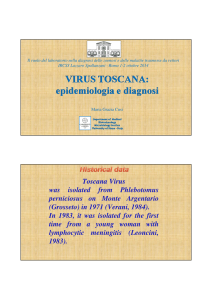
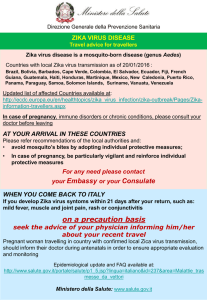
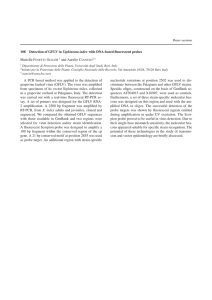
![Yellow-Fever_SA_2012-Ox_CNV [Converted]](http://s1.studylibit.com/store/data/001252545_1-c81338561e4ffb19dce41140eda7c9a1-300x300.png)
